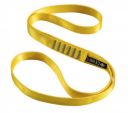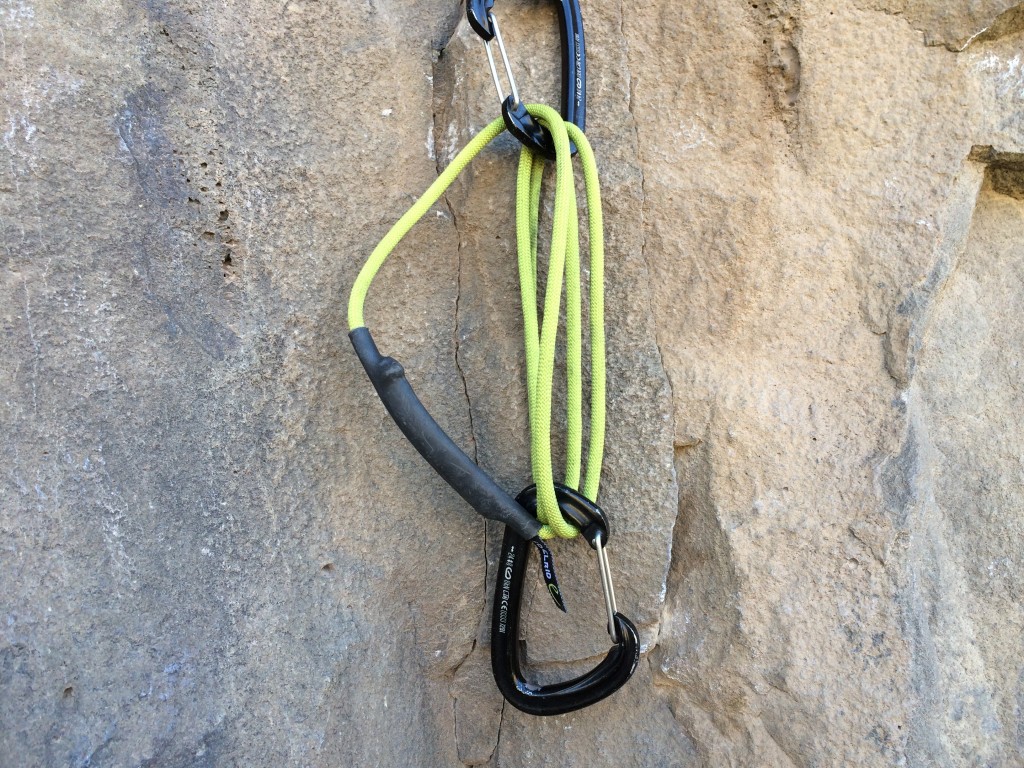Edelrid Aramid Cord Sling Review
Our Verdict
Compare to Similar Products
 This Product
Edelrid Aramid Cord Sling | |||||
|---|---|---|---|---|---|
| Awards | Best for Using as Pro | Best Overall Climbing Sling | Best for Building Anchors | Best Bang for the Buck | Best for Clipping Into a Belay |
| Price | $17.00 List | $10.00 List $9.95 at REI | $13.00 List $10.95 at Amazon | $6.95 at REI Compare at 3 sellers | $12.95 at Backcountry Compare at 2 sellers |
Overall Score  |
|||||
| Star Rating | |||||
| Bottom Line | A top pick because its stiffness and durability make it ideal for use as protection | Our Editors’ Choice winner because it is lighter and more compact than any other without compromising performance | A good sling that excels when it comes to equalizing multiple pieces of protection | A small trade-off in performance for a relatively large savings in cost when considering buying a whole rack | While not the smallest or lightest, has the notable advantage of great dynamic elongation |
| Rating Categories | Edelrid Aramid Cord... | Mammut Contact Dyneema | Metolius Open Loop... | Black Diamond Nylon... | Beal Dynamic Sling |
| Handle (25%) | |||||
| Knot Test (25%) | |||||
| Alpine Quickdraw Test (20%) | |||||
| Weight (15%) | |||||
| Bulk (15%) | |||||
| Specs | Edelrid Aramid Cord... | Mammut Contact Dyneema | Metolius Open Loop... | Black Diamond Nylon... | Beal Dynamic Sling |
| Type of Fiber | Aramid cord | Dyneema | Dyneema/Nylon weave | Nylon | Dynamic Rope |
| Measured weight | 43g | 19g | 47g (22g for 60cm) | 37g | 78g |
| Width Tested | 6mm | 8mm | 11mm | 18mm | 8.3mm |
| Length Tested | 60cm | 60cm | 120cm | 60cm | 60cm |
| Strength | 22kN | 22Kn | 22Kn | 22Kn | 22kN |
| Widths Available | 6mm | 8mm | 11mm; 13mm; 18mm | 18mm | 8.3mm |
| Lengths Available | 30cm; 40cm; 60cm; 90cm; 120cm | 60cm; 120cm | 25cm; 60cm; 120cm; 240cm; 480cm | 30cm; 60cm; 120cm; 240cm | 60cm; 120cm; 150cm |
Our Analysis and Test Results
The Edelrid Aramid Cord Sling is not made of flat or tubular webbing like most slings, but rather out of stiff 6mm diameter cord, sewn together at the ends (this part is covered by a thermo-molded black rubber casing). It comes in a wide variety of lengths, but we tested the 60cm length, which is a standard double-length sling, most commonly used for extending protection. The two qualities that make this sling unique compared to the others are its stiffness and durability. The stiffness allows one to reach over a foot further in order to wrap it around a horn, and also aids in pushing it through a thin thread, but also makes this sling a bit more awkward for tripling up into alpine draws than softer, more supple products.
The durability comes from being made out of aramid fibers, which are tightly woven in the sheath and core. These fibers do not have much if any stretch, but are very abrasion-resistant. Furthermore, the sheath protects the core, like in the design of a climbing rope, meaning the weight-bearing fibers are not exposed to the rock as they are on regular slings. Aramid is also highly heat resistant, making this a good choice for a prusik sling, or as a rappel backup.
Performance Comparison
Handle
Handle is a bit of a subjective matter, designed to describe how the product feels in the hand. There is no doubt that this cord sling feels stiff, which is one of its advantages. The sheath is very tightly woven, and at 6mm diameter, much thinner than an average climbing rope or even the Beal Dynamic Sling, which is also made with a sheath and core in a similar way. The fibers are not as soft to the touch, or as supple, as either the Dyneema or Nylon slings that we tested.
While there are some distinct advantages to having a sling made out of cord material, one of the obvious disadvantages is how the two ends of the cord are not flat, so don't layer on top of one another as nicely where they are sewn together. While this spot is covered by a black rubberized thermo-molded covering, it's very rigid, rather large, and doubles the thickness of the other parts of the sling. It feels like the design is as “best as one can expect”, but is simply not as nice or as smooth to handle as regular sewn slings, which don't need this large covering.
Knot Test
In our knot tests, we tied this cord into clove hitches and figure-eights on a bight knots numerous times, bouncing on them with our full weight to tighten them up, and then seeing how easy they were to untie. In the case of the Aramid Cord Sling, we have to say that knots are easier to untie than any other sling that we tested. The smooth, thin, round cord stock seems to not mold or cinch nearly as tightly as regular sling material, and untying the figure-eight knot, even after weighting, is a breeze.
The one thing we did notice, however, is that the stiff nature of this cord makes it slightly harder to tie the knots in than with a softer and more supple sling, and we found that in some cases we had to “dress” up the knots a little before weighting them. This means that they weren't automatically shaped correctly after tying, and had to be adjusted a little bit before we really tightened them down. This is a minor complaint.
Edelrid recommends the 30cm, or single length sling, in particular for use as a prusik sling (these days most commonly used in glacier travel or self-rescue situations). We tested this by tying many prusik knots, and once again found that the stiffness made it so the cord didn't automatically want to cinch down, and that the prssik also took a fair bit of dressing up before it gripped the rope correctly. Due to its heat resistance, they also claim that this would make a good rappel backup. Heat resistance for this sling is of paramount concern, since it runs over the rope, creating heat from friction, as you rappel. The most common knot for this use is a klemheist knot, and although our 60cm test sling is a bit too long for this usage, we tested tying it anyway. Klemheist knots in general are much easier and quicker to tie than prusik knots, and we found this one set up quickly using this sling.
Alpine Quickdraw Test
Despite the stiffness of this sling material, we found that it is possible to triple it up into alpine quickdraws without a problem. In fact, it is perhaps a bit easier than when using thicker Nylon slings. As one would expect, the large black covering over the sewn section presents a bit of a problem sliding through carabiners, but we found a nice trick, which is to situate one of the carabiners right next to the edge of it before beginning the process, and this positioning will guarantee that this casing will not need to slide through the 'biner, ensuring that it equalizes properly.
Because the cord is stiff, once tripled up into the alpine draw, it also doesn't hang straight down as naturally as regular slings, instead hanging a bit open. This takes up a bit more room on the rack, and may make it slightly more prone to catching on other items on your gear loops.
Weight
Our 60cm long double-length sling weighed 43g on our independent scale. While this isn't very much, it makes it heavier than any of the Dyneema or Nylon slings that we tested.
These slings weigh roughly double to the lightest Dyneema slings. We think that having one or two of them is advantageous, but there is no need for a whole set.
Bulk
This cord is 6mm in diameter, which is actually fairly thin compared to most of the slings in this review, which average about 11mm in width. Of course, it is hard to compare the width of a flat sling with the diameter of a round one, but by no means is this the bulkiest sling in the review.
That said, due to its stiffness, this sling won't pack down as small in the backpack as a supple sling, not will it sit on the harness quite as low profile either. For these reasons, we can't rate it with the best.
Value
While this sling is by no means what we would describe as expensive, it is among the most expensive slings that you can buy. However, for the right user in the right locations, we think that its particular advantages, especially its durability, make it very worth having on the harness. We think its performance versus price indicate good value. For those who are looking to stay on the lowest possible budget, there are a ton of slings that will cost you less.
Conclusion
The Edelrid Aramid Cord Sling is our Top Pick for Using as Pro because it is more durable than your average sling, and has added stiffness that makes it far easier to place with one hand while leading. This is an ideal sling for wrapping around blocks, over horns, behind flakes, or pushing through threads. They were designed with traditional limestone climbing in mind, like that found in the Dolomites of Italy, but are a great choice for all alpine climbing. We think one or two of these can be very handy tools to have on the rack, but see little reason why purchasing a whole selection would be necessary.


















